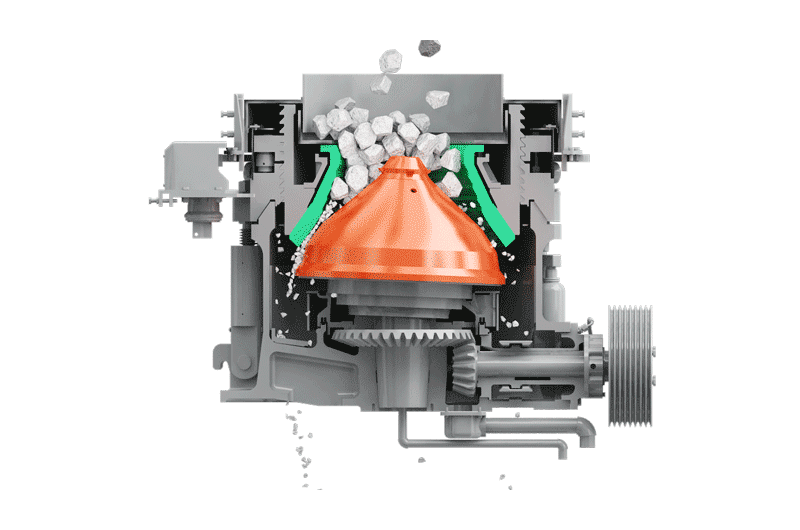
PY stone cone crusher machines are commonly used rock crushing machines in aggregate production, mining operations, and recycling applications. They are usually used in secondary, tertiary, and quaternary crushing stages
Application fields: mining, smelting, construction, highway, railway, water conservancy and chemical industry, and many other industries
Applicable materials: suitable for crushing hard and medium-hard ores and rocks, such as iron ore, limestone, copper ore, quartzite, granite, basalt, sandstone, pebbles, and various non-ferrous metal ores etc.
Introduction
PY stone cone crusher machines are commonly used rock crushing machines in aggregate production, mining operations, and sand recycling applications. They are usually used in secondary, tertiary, and quaternary crushing stages. However, in cases where the particle size of the processed material is small enough and does not require a traditional primary crushing stage, cone crushers can also perform the first stage of the crushing process. It is suitable for hard and medium-hard rocks and ores such as iron ore, copper ore, limestone, quartz, granite, sand, and gravel.
Working principle

When the PY high-efficiency stone cone crusher machine is working, the motor drives the eccentric sleeve to rotate through the pulley, V-belt, transmission shaft, and bevel gear. The main shaft rotates and swings under the force of the eccentric sleeve, causing the crushing wall above the main shaft to sometimes approach and sometimes leave the mortar wall. The material is continuously impacted, squeezed, and bent in the annular crushing chamber composed of the crushing wall and the mortar wall, and is crushed. The crushed material is discharged from the discharge port at the bottom.
Performance characteristics
1. High performance and strong pressure resistance
2 . The stone cone crusher machine integrates eccentricity, cavity type, and equipment motion parameters, which greatly improve the final product quality, production capacity, and efficiency.
3 . Various cavity types to meet various finished product requirements. Various cavity types, a large crushing ratio and flexible eccentricity provide the most reasonable solution for various crushing processes. The type of crushing cavity is determined by the purpose of the ore. The standard type is suitable for medium crushing, the medium type is suitable for fine crushing, and the short head type is suitable for ultra-fine crushing.
4. Cone crushers are very suitable for size reduction and shaping downstream of the crushing circuit. They reduce the material in the crushing cavity by continuous compression between the fixed element (bowl liner) and the moving element (cover sleeve).
5. Fully automatic control. The fully automatic control system provides multiple operating modes, such as manual control, constant discharge control, and constant power control, for users to choose.
Crushing process
Feeding Stage:
Stone is fed into the cone crusher. The feeding process ensures that the stone is delivered to the crusher in a regular and controlled manner. At this stage, large stones are prepared to be converted into smaller stones.
Crushing Stage:
The eccentric shaft in the cone crusher rotates the crusher head. This rotational motion causes the stone to be crushed. The stone caught in the gap between the cone head and the main body is crushed and broken. The stone is crushed by the pressure and friction between the crusher head and the cone.
Screening Stage:
The stone that has passed the crushing process passes through the holes at the bottom of the cone crusher. Based on the size of these holes, the stones of the required size pass through the screening process, while the larger stones that are not required are screened. This step is essential to obtain stones that meet the specified standards.
Technical Parameters
| Model | Broken Diameter (ft)(mm) | Cavity type | Feeding Size(mm) | Adjustment Range(mm) | Motor Power (kw) | Weight (t) | Capacity(t/h) | |
| Closing side | Opening side | |||||||
| PYS-B0910 | 3Ft 914 | Fine | 83 | 102 | 9-22 | 75 | 14.6 | 40-100 |
| PYS-B0917 | Coarse | 159 | 175 | 13-38 | 50-180 | |||
| PYS-B0918 | Super Coarse | 163 | 178 | 25-38 | 100-180 | |||
| PYS-B1313 | 4-1/4Ft 1295 | Fine | 109 | 137 | 18-31 | 155 | 25.8 | 100-200 |
| PYS-B1321 | Medium | 188 | 210 | 16-38 | 110-280 | |||
| PYS-B1324 | Coarse | 216 | 241 | 19-51 | 150-380 | |||
| PYS-B1325 | Super Coarse | 238 | 259 | 25-51 | 210-390 | |||
| PYS-B1620 | 5-1/2(Ft) 1676 | Fine | 188 | 209 | 16-38 | 240 | 50.8 | 160-360 |
| PYS-B1624 | Medium | 216 | 241 | 22-51 | 230-460 | |||
| PYS-B1626 | Coarse | 331 | 268 | 25-64 | 270-690 | |||
| PYS-B1636 | Super Coarse | 38-64 | 230-740 | |||||
| PYS-B2127 | 7(2FtHD) 2137 | Fine | 253 | 278 | 19-38 | 400 | 89.5 | 340-790 |
| PYS-B2133 | Medium | 303 | 334 | 25-51 | 550-1090 | |||
| PYS-B2136 | Coarse | 334 | 369 | 31-64 | 710-1390 | |||
| PYS-B2146 | Super Coarse | 425 | 460 | 38-64 | 800-1490 | |||
Note: Technical data are subject to change without prior notice.

Contact: Hebe Wang
Phone: +86 150 9289 4665
Tel: +86 150 9289 4665
Email: info@sandmancrusher.com
Add: No.23 Yihe Road,Linyi City, Shandong Province, China
We chat
